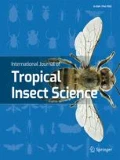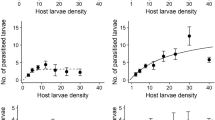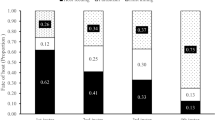Abstract
The biological hypothesis that female parasitoids can adjust their fecundity schedule according to host availability, and tradeoff longevity with fecundity was tested in a thelytokous oophagous parasitoid, Trichogramma brasiliensis Ashmead (Trichogrammatidae: Hymenoptera) parasitising the rice moth, Corcyra cephalonica (Stainton) (Lepidoptera: Pyralidae). The tradeoff between early and late reproduction revealed that this wasp was able to exploit practically all available hosts during the first day or first few days of adult life. During spells of host unavailability, it was able to adjust its fecundity schedule accordingly. There was a negative relationship between survival and reproduction. Adult females survived shorter (10 days) when an unlimited supply of hosts was present, but longer (16 days) when no hosts were provided. These observations suggest the potential suitability of T. brasiliensis for inundative releases even in conditions of fluctuating host availability.
Résumé
L’hypothèse selon laquelle les femelles parasitoïdes peuvent ajuster leur fécondité en fonction de la disponibilité des hôtes, et adapter leur longévité à leur fécondité a été testée chez un parasitoïde thélytoque oophage, Trichogramma brasiliensis Ashmead (Trichogrammatidae: Hymenoptera), parasitant la pyrale du riz, Corcyra cephalonica (Stainton) (Lepidoptera: Pyralidae). Le choix entre une reproduction précoce ou tardive indique que cette guêpe est capable d’exploiter pratiquement tous les hôtes disponibles pendant le premier ou les premiers jours de sa vie adulte. En l’absence d’hôtes, elle est capable d’ajuster sa fécondité en conséquence. Il y a une relation négative entre la survie et la reproduction. Les femelles adultes vivent moins longtemps (10 jours) lorsque les hôtes sont en nombre illimité et plus longtemps (16 jours) en l’absence d’hôtes. Ces observations suggèrent que T. brasiliensis est adapté à des lâchers inondatifs même lorsque la disponibilité des hôtes est variable.
Similar content being viewed by others
References
Bai B. and Smith S. M. (1993) Effect of host availability on reproduction and survival of the parasitoid wasp Trichogramma minutum. Ecol. Entomol. 18, 279–286.
Bai B., Luck R. P., Foster L., Stephens B. and Janseen J. A. M. (1992) The effect of host size on quality attributes of the egg parasitoid, Trichogramma pretiosum. Entomol. Exp. Appl. 64, 37–48.
Bell G. and Koufopanov V. (1986) The cost of reproduction. Oxford surveys in Evol. Biol. 3, 83–131.
Drost Y. C. and Carde R. J. (1992) Influence of host deprivation on egg load and oviposition behaviour of Brachymeria intermedia, a parasitoid of gypsy moth. Physiol. Entomol. 17, 230–234.
Duncan D. B. (1951) A significance test for differences between ranked treatments in an analysis of variance. Va. J. Sci. 2, 171–189.
Kopelman A. H. and Chabora P. C. (1992) Resource variability and life history parameters of Leptopilina boulardi (Hymenoptera: Eucoilidae). Ann. Entomol. Soc. Am. 85, 195–199.
Manickavasagam S., Baskaran P. and Ramesh B. (1995) Does the host availability regulate fecundity and longevity in Trichogramma? Proceedings of the 4th Intl. Symp. on Trichogramma and Other egg Parasitoids, Cairo, Egypt. 1994. INRA 72, 91–93.
Manickavasagam S., Paul A. V. N. and Farooqi S. I. (1994) Biological attributes of four species of Trichogramma ( Hym: Trichogrammatidae) A comparative study. Insect Sci. Applic. 15, 173–176.
Moller H., Smith R. H. and Sibly R. M. (1989) Evolutionary demography of a bruchid beetle. I. Quantitative genetical analysis of the female life history. Funct. Ecol. 3, 673–681.
Roitberg B. D. (1989) The cost of reproduction in rosehip flies, Rhagoletis bassiola: Eggs are time. Evol. Ecol. 3, 183–188.
Subramaniam T. V. (1937) Preliminary experiments on mass production of Trichogramma parasites for control against sugarcane borers in Mysore. Ind. J. Agric. Sci. 7, 149–155.
Author information
Authors and Affiliations
Corresponding author
Rights and permissions
About this article
Cite this article
Ramesh, B., Manickavasagam, S. Tradeoff Between Longevity and Fecundity in Relation to Host Availability in a Thelytokous Oophagous Parasitoid, Trichogramma brasiliensis Ashmead (Trichogrammatidae: Hymenoptera). Int J Trop Insect Sci 23, 207–210 (2003). https://doi.org/10.1017/S1742758400023602
Accepted:
Published:
Issue Date:
DOI: https://doi.org/10.1017/S1742758400023602




